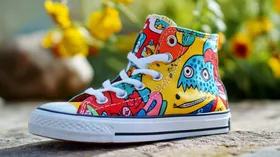How to Treat Your Child’s Ankle Sprain at Home
Discover some effective home remedies to promote healing and relief for your child’s ankle sprain.
Updated August 14, 2023
Traumatic ankle and foot injuries occur frequently and can be a real challenge for paediatric orthopaedics and radiologists since these often present as simple ankle sprains at first.
But an ankle sprain in a younger child is less common than fractures because children's bone growths in the ends of the long bones in the foot and ankle are weaker than muscles and tendons. Sprains occur when the ligaments surrounding the ankle are stretched or torn.
Luckily, sprain-related symptoms—swelling, bruising, pain, difficulty walking, or limping—can be treated at home conservatively. So, read on to learn how you can support your child's recovery from ankle sprains.
» Do you have a son? See these high-top shoes for boys for ankle stability and strength
Treating Ankle Sprains in Children
Sprains can result from landing awkwardly or twisting your ankle, walking or running on uneven ground, or engaging in physical activities. So, here are some treatment methods for ankle sprains:
- Rest: Encourage your child to avoid putting weight on the injured ankle and allow it to rest.
- Icing: Apply an ice pack or ice wrapped in a towel on the injured area for about 15-20 minutes every few hours for the first 2-3 days after the sprain.
- Gentle exercises: Assist with a range of gentle motion exercises like moving the ankle up and down (and inward and outward), circling the foot, and mild stretches to minimise stiffness post-injury.
- Elevation: In case of swelling, place your child's ankle on a stack of pillows while they are watching TV, reading books, and so on.
- Supportive shoes: Shoes with proper cushioning and sturdy heels can provide stability and aid the healing process post-ankle sprains.
Pro Tip: All ankle movements during rehabilitation exercises are to be done very gently, especially inversion and eversion of the foot.
» Check out the best girls' high-cut sandals with ankle support
Heal the Right Way
First Walkers’ shoes vary in style and benefits and have sizes from 2-11.5 for pre-walkers to juniors. Some benefits include breathable fabric and cushioned soles for maximum comfort, suitability with orthotics, and shock-absorbing qualities to help bring stability to the ankle joint and prevent side-to-side movement that can worsen the sprain. Take a look at our range and help make your child's steps safer and more comfortable.
Related Articles

10 Best Kids' Shoes for Orthotics: Comfort, Support, & Durability
Amy Elder
December 6, 2024

Orthotic Shoes, Sneakers and Boots for Kids in Winter
First Walkers
June 10, 2025

6 Best Multi-Coloured Sneakers to Jazz Up Your Kids' Wardrobes
Babafemi Adebajo
December 6, 2024

What Makes a Shoe Orthotic-Friendly for Kids?
Babafemi Adebajo
June 12, 2024

Orthopaedic Shoes for Toddlers: Challenges & Benefits
Caitlin Snethlage
November 30, 2024
Related Posts
Bhashwati Deb Barma
10 Best High Top Shoes for Boys for Ankle Stability and Strength
First Walkers
